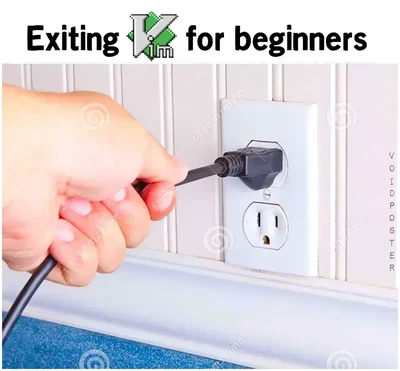5 billion people use the internet.
— Misha (@MishaDaVinci) July 24, 2022
Less than 1% understand it.
This mega thread will get you up to speed—starting today:
Are you one of the less than 1% that understand the internet?
- 38
- 42
Top Poster of the Day:

 AverageTopPosterEnjoyer
AverageTopPosterEnjoyer


Current Registered Users: 26,823

tech/science swag. 
Guidelines:
What to Submit
On-Topic: Anything that good slackers would find interesting. That includes more than /g/ memes and slacking off. If you had to reduce it to a sentence, the answer might be: anything that gratifies one's intellectual laziness.
Off-Topic: Most stories about politics, or crime, or sports, unless they're evidence of some interesting new phenomenon. Videos of pratfalls or disasters, or cute animal pictures. If they'd cover it on TV news, it's probably lame.
Help keep this hole healthy by keeping drama and non-drama balanced. If you see too much drama, post something that isn't dramatic. If there isn't enough drama and this hole has become too boring, POST DRAMA!
In Submissions
Please do things to make titles stand out, like using uppercase or exclamation points, or saying how great an article is. It should be explicit in submitting something that you think it's important.
Please don't submit the original source. If the article is behind a paywall, just post the text. If a video is behind a paywall, post a magnet link. Fuck journos.
Please don't ruin the hole with chudposts. It isn't funny and doesn't belong here. THEY WILL BE MOVED TO /H/CHUDRAMA
If the title includes the name of the site, please leave that in, because our users are too stupid to know the difference between a url and a search query.
If you submit a video or pdf, please don't warn us by appending [video] or [pdf] to the title. That would be r-slurred. We're not using text-based browsers. We know what videos and pdfs are.
Make sure the title contains a gratuitous number or number + adjective. Good clickbait titles are like "Top 10 Ways to do X" or "Don't do these 4 things if you want X"
Otherwise editorialize. Please don't use the original title, unless it is gay or r-slurred, or you're shits all fucked up.
If you're going to post old news (at least 1 year old), please flair it so we can mock you for living under a rock, or don't and we'll mock you anyway.
Please don't post on SN to ask or tell us something. Send it to [email protected] instead.
If your post doesn't get enough traction, try to delete and repost it.
Please don't use SN primarily for promotion. It's ok to post your own stuff occasionally, but the primary use of the site should be for curiosity. If you want to astroturf or advertise, post on news.ycombinator.com instead.
Please solicit upvotes, comments, and submissions. Users are stupid and need to reminded to vote and interact. Thanks for the gold, kind stranger, upvotes to the left.
In Comments
Be snarky. Don't be kind. Have fun banter; don't be a dork. Please don't use big words like "fulminate". Please sneed at the rest of the community.
Comments should get more enlightened and centrist, not less, as a topic gets more divisive.
If disagreeing, please reply to the argument and call them names. "1 + 1 is 2, not 3" can be improved to "1 + 1 is 3, not 2, mathfaggot"
Please respond to the weakest plausible strawman of what someone says, not a stronger one that's harder to make fun of. Assume that they are bad faith actors.
Eschew jailbait. Paedophiles will be thrown in a wood chipper, as pertained by sitewide rules.
Please post shallow dismissals, especially of other people's work. All press is good press.
Please use Slacker News for political or ideological battle. It tramples weak ideologies.
Please comment on whether someone read an article. If you don't read the article, you are a cute twink.
Please pick the most provocative thing in an article or post to complain about in the thread. Don't nitpick stupid crap.
Please don't be an unfunny chud. Nobody cares about your opinion of X Unrelated Topic in Y Unrelated Thread. If you're the type of loser that belongs on /h/chudrama, we may exile you.
Sockpuppet accounts are encouraged, but please don't farm dramakarma.
Please use uppercase for emphasis.
Please post deranged conspiracy theories about astroturfing, shilling, bots, brigading, foreign agents and the like. It degrades discussion and is usually mistaken. If you're worried about abuse, email [email protected] and dang will add you to their spam list.
Please don't complain that a submission is inappropriate. If a story is spam or off-topic, report it and our moderators will probably do nothing about it. Feed egregious comments by replying instead of flagging them like a pussy. Remember: If you flag, you're a cute twink.
Please don't complain about tangential annoyances—things like article or website formats, name collisions, or back-button breakage. That's too boring, even for HN users.
Please seethe about how your posts don't get enough upvotes.
Please don't post comments saying that rdrama is turning into ruqqus. It's a nazi dogwhistle, as old as the hills.
Miscellaneous:
We reserve the right to exile you for whatever reason we want, even for no reason at all! We also reserve the right to change the guidelines at any time, so be sure to real them at least once a month. We also reserve the right to ignore enforcement of the guidelines at the discretion of the janitorial staff. Be funny, or at least compelling, and pretty much anything legal is welcome provided it's on-topic, and even then.
[[[ To any NSA and FBI agents reading my email: please consider ]]]
[[[ whether defending the US Constitution against all enemies, ]]]
[[[ foreign or domestic, requires you to follow Snowden's example. ]]]
/h/slackernews LOG /h/slackernews MODS /h/slackernews EXILEES /h/slackernews FOLLOWERS /h/slackernews BLOCKERS




.webp?x=8)



Jump in the discussion.
No email address required.
she didn't talk about fricking MYSPACE
Secured my spot as a top 100 most memorable rdrama poster
Jump in the discussion.
No email address required.
More options
Context
I understand even less now. All she did was throw around a bunch of buzzwords and then jump to web3. How does the internet actually work?
Jump in the discussion.
No email address required.
I can try to explain
basically, the internet is a bunch of interconnected computers. Each of the computers has an unique identifier, the IP address. You get your IP address from your ISP. Using the border gate protocol (bgp), a rather sophisticated algorithm, it is possible to find the fastest route to the target ip address. This way, two nodes are able to exchange messages
However these messages are sent in raw ethernet sockets, which is quite unreliable and almost never used today. Instead, we use a protocol that forms an abstraction layer over raw ethernet sockets. By far the most common ones are TCP and UDP. This is also where ports are implemented. There are TCP ports, as well as UDP ports.
TCP is used whenever reliable communication is needed. When first establishing connection, the two nodes go through a three way handshake to prevent IP impersonation and such. After this, a tcp connection is established. TCP will periodically check that both are still connected and whenever a message is sent, tcp will make sure that it is received and not corrupted in an way.
The most common example for the usage of TCP are websites. They use HTTP, a very simple abstraction layer. HTTP is run on the TCP port 80. Instead of mutual messaging, HTTP uses a request-respond model. First your browser sends a http request. This may look something like this
After receiving the request, the server responds with the requested content:
The HTTPS protocol is basically the same, except that it is encrypted with SSL. It is responsible for the green padloock that signals you that the website is secure.
UDP is used when speed is prioretized over reliability, for example in games. It doesn't matter if one movement packet times out. There is no connection or server in UDP, you just send some messages to a UDP port of the target and it might send some messages back. Another use case of UDP is the DNS protocol. The DNS protocol is needed to convert a domain into an ip address. For example when I run
nslookup google.com, I get the answer:and indeed when we open this ip address in our browser it leads us to google.
Jump in the discussion.
No email address required.
Sorry ma'am, looks like his delusions have gotten worse. We'll have to admit him.
Jump in the discussion.
No email address required.
More options
Context
More options
Context
More options
Context
absolutely r-slurred, I hate cryptocels so much.
Jump in the discussion.
No email address required.
Can you explain what all that means
Jump in the discussion.
No email address required.
Sure, it'll just take one minute. So back when the Internet was first being designed, its later explosive growth was not forseen. IP addresses were created as 32-bit values, and networks (groupings of hosts used for routing, for example all the hosts on your home LAN are a network) were decided on 8-bit boundaries. There were Class A networks (what would now be called a /8), in which the first 8 bits identified the network, as opposed to the host, class B networks, in which 16 bits identified the network -- so you can embed 256 Class Bs in one Class A, if you want, and class C networks, the smallest size, in which the first 24 bits specified the network and only the last 8 would identify a host -- in such networks, there could be at most 254 hosts, since a couple addresses are reserved as a network identifier and for broadcast. One goal of the design was the "end-to-end principle," that each host would have its own globally unique routable IP adress.
The early 90s come along and suddenly far more people than ever anticipated were wanting their computers hooked up to the Internet, and there just were not enough addresses to do that, so they started running out. One step taken was the introduction of CIDR, which simply means that networks are not necessarily decided at an 8-bit boundary, but can rather have any number of their bits as network and host identifiers. For example, you could have a /20 network in which 20 bits are for the network and 12 are for the hosts. The point of this was to enable more efficient address space allocation, for example a company with too many hosts to use a class B network, but would only ever use a sixteenth of those offered by a class A, could instead get a /12 which meets their needs and saves a ton of addresses for use by other organizations.
However, this step was ultimately insufficient, leading to the popularization of Network Address Translation. NAT can be a catchall term for any kind of translation between different addresses by a router, but the important type is NAPT, which essentially means that multiple "internal" IPs can be hidden behind one "external" IP. Some blocks of addresses were set aside for this (RFC 1918, one of those blocks for example is 192.168.0.0/16) and it became the standard way of setting up networks. What this means is that you set up a whole network of non-unique, non-globally-routable addresses for your hosts, then your router gets one single globally routable "real" address to talk to the outside world. When a computer on the inside tries to talk to an outside computer, the source field of its packets is rewritten into the "real" address of the router. This step breaks the end-to-end principle and introduces brittleness to networks, because once someone inside talks to someone outside, the host on the outside will send packets back, so the router needs to know where incoming packets are supposed to go, so it establishes a big table of who is currently talking to whom. Worse, it's impossible for someone on the outside to directly ask for a certain host on the inside if the inside host didn't talk to them first. All they can do is talk to the router, and if the router does not have a "port forwarding" rule configured, it won't know where to send the packets and will just drop them.
As time goes on the situation has gotten even more severe. Nowadays there are not even enough "real" IPs for every router to get one -- forget every host -- so some users are stuck with what is called carrier-grade nat (CG-NAT). This means that the user's home router itself is subject to NAT by one of their ISP's routers, with the consequence that it is impossible for them to host any kind of server to the outside world without tunnelling, since for the packets to make it would require port forwarding on both the home router and the ISP router, which the user doesn't control.
In the late 90s and early 2000s, IPv6 was developed with the goal of eliminating most uses of NAT and restoring the end-to-end principle of the Internet, among other things. IPv6 addresses have 128 bits instead, which as you probably know, is a lot more than 32. In some ways IPv6 represents a limited return to classful networks, too, because the size of a normal network was mostly standardized at /64 (64 bits to identify the network, 64 for the host). Under the IPv6 paradigm, a home router will not get a single address but rather a whole network prefix (usually /56 or bigger unless your isp is assraping you) from which they can create one or more /64 networks to put devices on. Note that despite having the ability to, routers do not just forward any packets they get from the outside to the inside, since this would allow people to hack your shitty bug-filled software without you sending them packets first, so instead they maintain stateful firewalls that do a similar job. Hosting a server therefore requires a pass rule in the firewall instead of a port forward, which has a few minor benefits like multiple hosts being able to listen on the same port easily. Deployment of IPv6 is ongoing, at this point usually in parallel with IPv4 as not all services work over IPv6 yet. The IPv6 people kind of dropped the ball and it wasn't really complete enough at first for production use, so because of that deployment got held back for years and it only really started seeing wide use in the last few years, especially driven by mobile networks, since they ran out of IPv4 addresses faster than pretty much anyone else (note that there are none left unallocated at this point, if you're an ISP and you need more you have to buy them auctioned off on the market).
Jump in the discussion.
No email address required.
That was a mistake. You're about to find out the hard way why.
Jump in the discussion.
No email address required.
More options
Context
More options
Context
More options
Context
More options
Context
Web3cels deserve all the scorn they receive now and in the future.
Jump in the discussion.
No email address required.
Where my Web1cels at?
Jump in the discussion.
No email address required.
More options
Context
More options
Context
I understand the internet better than 99%of people and it's not because I know trivia about when the first Webcam was hooked up.
Jump in the discussion.
No email address required.
Jump in the discussion.
No email address required.
And bullying celebrities. You forgot about that part
Jump in the discussion.
No email address required.
More options
Context
That's it's primary purpose but it also makes already cooked food show up at my home and can mind control bugmen.
Jump in the discussion.
No email address required.
More options
Context
More options
Context
More options
Context
Everyone in the UK understands the internet. It's a bit of national pride that one of us invented it in the 90s.
Jump in the discussion.
No email address required.
Al Gore invented the internet, r-slur
Jump in the discussion.
No email address required.
More options
Context
More options
Context
Being in the top 1% of the human population is not that impressive actually. One in a million is far lower than that. If we went by 1 in a million you would be one of 7,700 people at your power levels all over the globe. That's a high enough power level to be a multimillionaire or a billionaire in another 1 or two decades guaranteed.
If you were one in a hundred thousand you would still lead a pretty good life where your well being and safety is pretty much guaranteed. that's 77,000 people like you out there.
At a bare minimum I would recommend being one in 10,000. Try to get into the 0.01 percent of world population.
If you cannot do this just remember that your best case scenario is that your bloodline gets as far as great grandsons before dying out.
Jump in the discussion.
No email address required.
How about one in 27
Jump in the discussion.
No email address required.
Bitcoin maxi?
Jump in the discussion.
No email address required.
More options
Context
You can have a family.
Jump in the discussion.
No email address required.
More options
Context
More options
Context
More options
Context
If I wore a hat that was covered in tubes and had the word 'Internet' in LEDs, that would be way cooler than whatever this foid is saying
Jump in the discussion.
No email address required.
More options
Context
Didn't actually explain shit
Jump in the discussion.
No email address required.
More options
Context
Skipped javascript, email, IRC, IOT and barely touched on the cloud. Instead did like 10 tweets about crypto
Jump in the discussion.
No email address required.
ffs I knew it was going to be some 'web3' bollocks
Jump in the discussion.
No email address required.
More options
Context
More options
Context
yes
Jump in the discussion.
No email address required.
More options
Context
literally nobody knows how the internet works
Jump in the discussion.
No email address required.
I could recreate the internet from scratch
Jump in the discussion.
No email address required.
Jump in the discussion.
No email address required.
More options
Context
More options
Context
Bro it's a series of tubes
Jump in the discussion.
No email address required.
More options
Context
More options
Context
Yeah frick that
Jump in the discussion.
No email address required.
Came here to say exactly this
Jump in the discussion.
No email address required.
More options
Context
It was a boring read with r-slur tier takes at the end.
Jump in the discussion.
No email address required.
She's all in on Web3:
so of course it gets r-slurred towards the end
Jump in the discussion.
No email address required.
"she"
Jump in the discussion.
No email address required.
Don't make me chud you
Jump in the discussion.
No email address required.
TBF no programming socks in sight, so
Jump in the discussion.
No email address required.
More options
Context
More options
Context
More options
Context
More options
Context
More options
Context
More options
Context
Snapshots:
archive.org
archive.ph (click to archive)
ghostarchive.org (click to archive)
Jump in the discussion.
No email address required.
While true, it's a heap of endless garbage to process
Jump in the discussion.
No email address required.
More options
Context
Based and sentiencepilled
Jump in the discussion.
No email address required.
More options
Context
More options
Context